Society of Menzoberranzan Sam’s Server
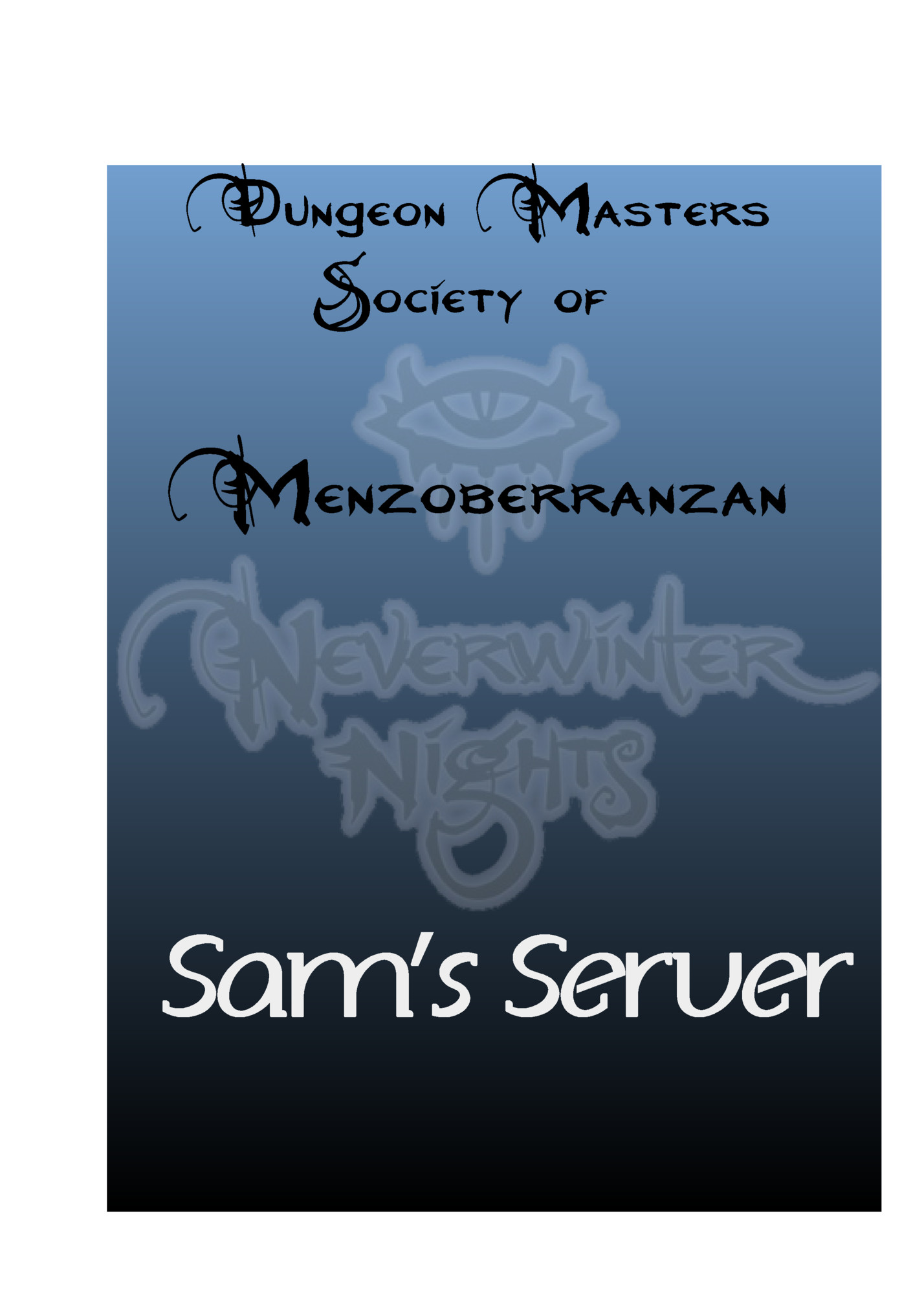
This is a WIP.. This section is specifically for our server Read the DM Guide from the DMFI
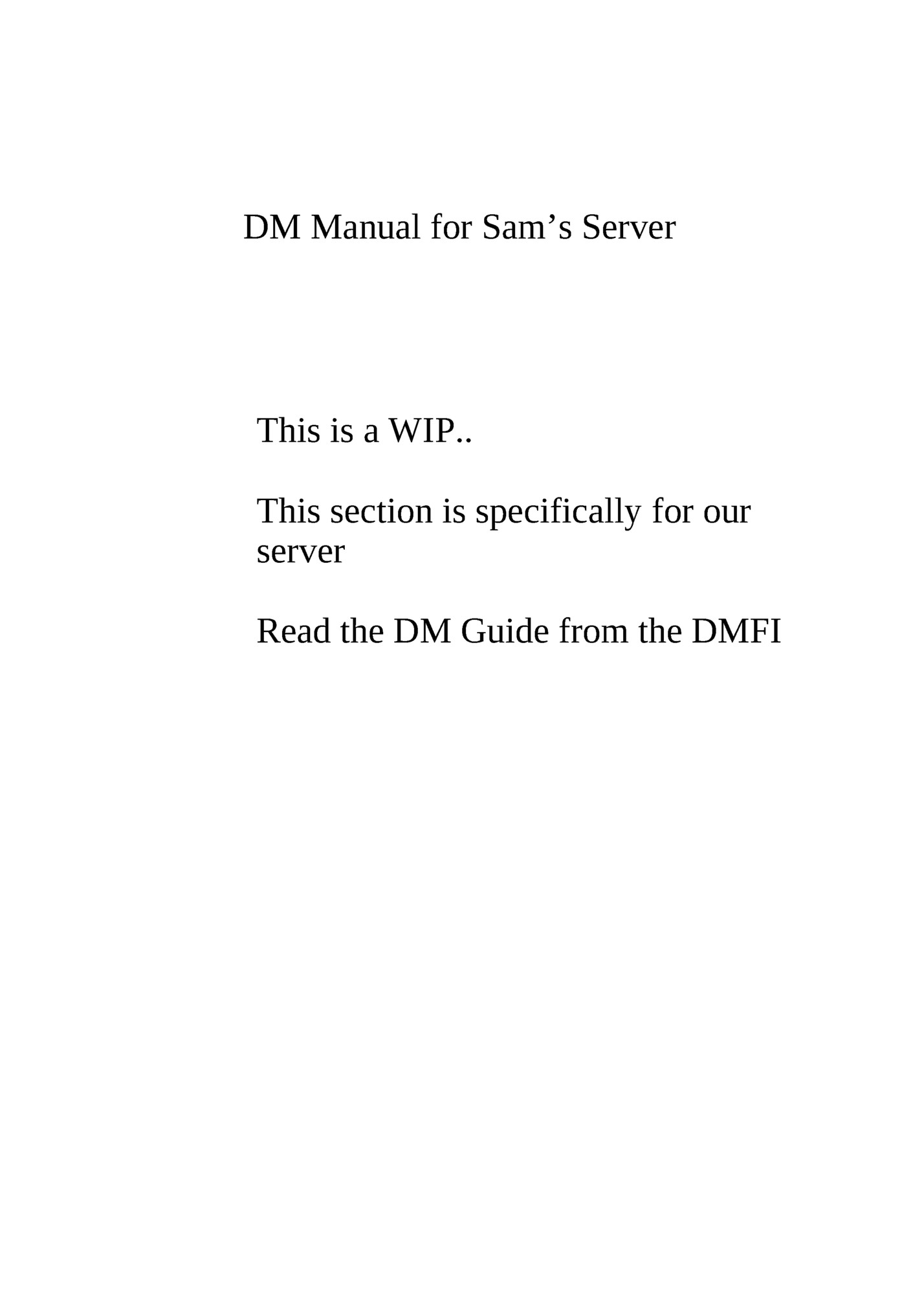
By Carlo and brought to you by the DM-Friendly Initiative Table of Contents I. II. III. IV. Introduction: What’s Different about DMing in Persistent Worlds? PW Content: Dynamic, Static and PC-centric Consistency and Continuity Community Relations This is a revised and updated guide for the Neverwinter Nights: Enhanced Edition (NWN:EE) era. The contents are based on a discussion that took place on the old Bioware DM-Friendly Initiative (DMFI) Guild forum. Thanks go to all those DMs who contributed their ideas and comments. For additional resources related to persistent worlds (PWs) and DMing resources, you can: • See the list of PW project descriptions on the Neverwinter Connections (NWC) Persistent World Announcements forum • View scheduled DM’d sessions for PWs on the NWC Events Calendar • Visit Beamdog’s NWN:EE Persistent Worlds and Multiplayer forum For those looking to get more into multiplayer NWN, the NWN:EE Multiplayer Resource page is a good place to start. I. Introduction: What's Different about DMing in Persistent Worlds? DMing in Neverwinter Nights (NWN) brings its own set of opportunities and challenges, in addition to the common ones faced by DMs in all environments, including classic pen-and-paper (PnP) or modern hybrids like Fantasy Grounds. The DM’s role in all cases is that of a world builder, story author, and encounter manager, who has the pleasure and responsibility of making the game setting come alive to appropriately challenge and reward players. As those who have tried it are aware, DMing in a persistent world (PW) environment - which in theory is open 24/7 - has unique demands. Neverwinter 3
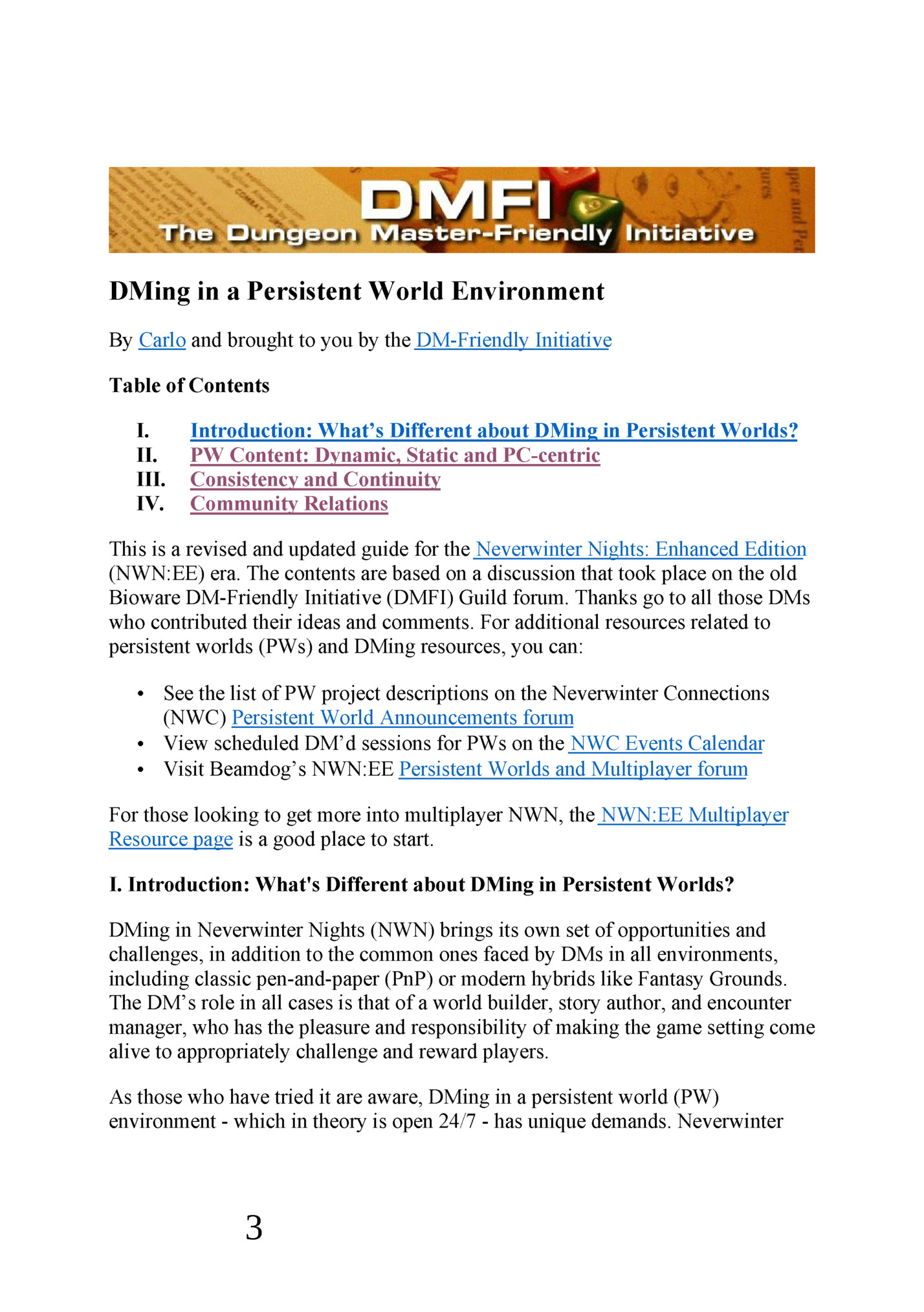
originally designed for a module-based and campaign-style format. In other words, a consistent party of PCs is expected to participate in a series of DM’d adventures, which may take place in an open-ended campaign or be part of a fixed story arc. The party is also expected to stay together for the duration of the adventure. (It’s worth noting that in NWN, having a split party is more easily handled by a DM than in PnP, since the action can continue simultaneously in different locations.) Finally, the DM at the end of an adventure has the option of moving on to a separate location for fresh adventures. In contrast, a persistent world is set up to be a game simulation of a pre-defined area of a world, whose content exists independent of party-based adventures. This opens up new possibilities, but at the same time presents unique DMing challenges, especially if DMs are serious about doing things like maintaining plot continuity and internal gameworld logic over time. Parties often will not have the same makeup of players during the course of even a single session, as players drop out and arrive over the course of several hours. Player participation over the course of a whole story arc, which may unfold over weeks or months, is also inevitably variable. A DM on a PW therefore needs to be much more flexible in crafting and executing plotlines. For example, they cannot rely on a single PC’s presence for anything that is absolutely critical to the plot, as that PC may well drop out or move on before it is completed. Because of these factors, DMs in a PW environment often can be more effective by focusing their efforts on mastering the world’s setting and how its PC and NPC inhabitants typically interact and conflict, rather than only devising and trying to run one-off, individual party-based quests. DMs can also benefit from conceiving storylines, events, and in-game devices that help keep the world alive for the players even in the absence of in-game DM attention – which is often a relatively scarce resource, even in large PW projects. At the same time, taking this conceptual approach can also give DMs richer possibilities when they are in-game. How can a DM do this? Below we'll look at practical approaches to creating and managing gameworld content, along with how DMs can best work with each other and with players to make their PW a success. II. PW Content: Dynamic, Static and PC-centric DMs in a PW can quickly see that traditional-style quests and similar content are often consumed by players far more rapidly than it takes to build and test said

players on the server will never be 100%, so for most of the time that 24/7 clock runs, the majority of players will be on their own in the gameworld. Many PWs address this situation by making repeatable scripted content available, sometimes with persistent flags preventing those who have completed them from doing them again. When this is done with an eye on the gameworld’s internal logic, it can be a benefit to immersion, provide useful repeatable tasks for player characters (PCs) beyond just mindless “farming” of the same content, and also allow for DM participation. Examples of this type of dynamic content include being hired to guard a daily caravan between two towns, or to patrol a large border area that has periodic monster raids. Setting the monetary reward appropriately and having randomly generated encounters (both hostile and non-hostile) based on party level, whether scripted or DM-controlled, can help maintain a consistent level of challenge, reward and interest. In contrast, when “static content” is placed without regard to continuity or logic, it can significantly detract from gameworld immersion and players’ experience. Killing the same dire rat in the same farmer's barn, repeatedly delivering the same letter from the same non-player character (NPC), killing the same ogre chieftain again in his same lair - these types of quests quickly become stale, and also highlight the lack of progress available to players in the gameworld. If content does not logically change as a result of player actions, then the PW experience can becomes centered solely around a PC’s level progression and individual power usually measured against that of other PCs - rather than on roleplaying a unique character in the context of an unfolding story. Some action-oriented PWs don't have a problem with this type of approach, so it depends on who your audience is. Even with an Action audience, though, dynamic content is usually more appreciated as something new and challenging. DM techniques for creating content As a supplement to traditional-style quest content, which likely will still have a place in the gameworld, DMs can enhance the experience by creating ongoing plotlines involving task-giving NPCs that are open to continuing PC involvement. Most importantly, this means that PCs will be able to continue their plot-related actions without the NPC always being actively DM’d. One technique is to introduce NPCs – typically faction leaders or representatives – that have specific ambitions and want to use PCs to further these ambitions. The
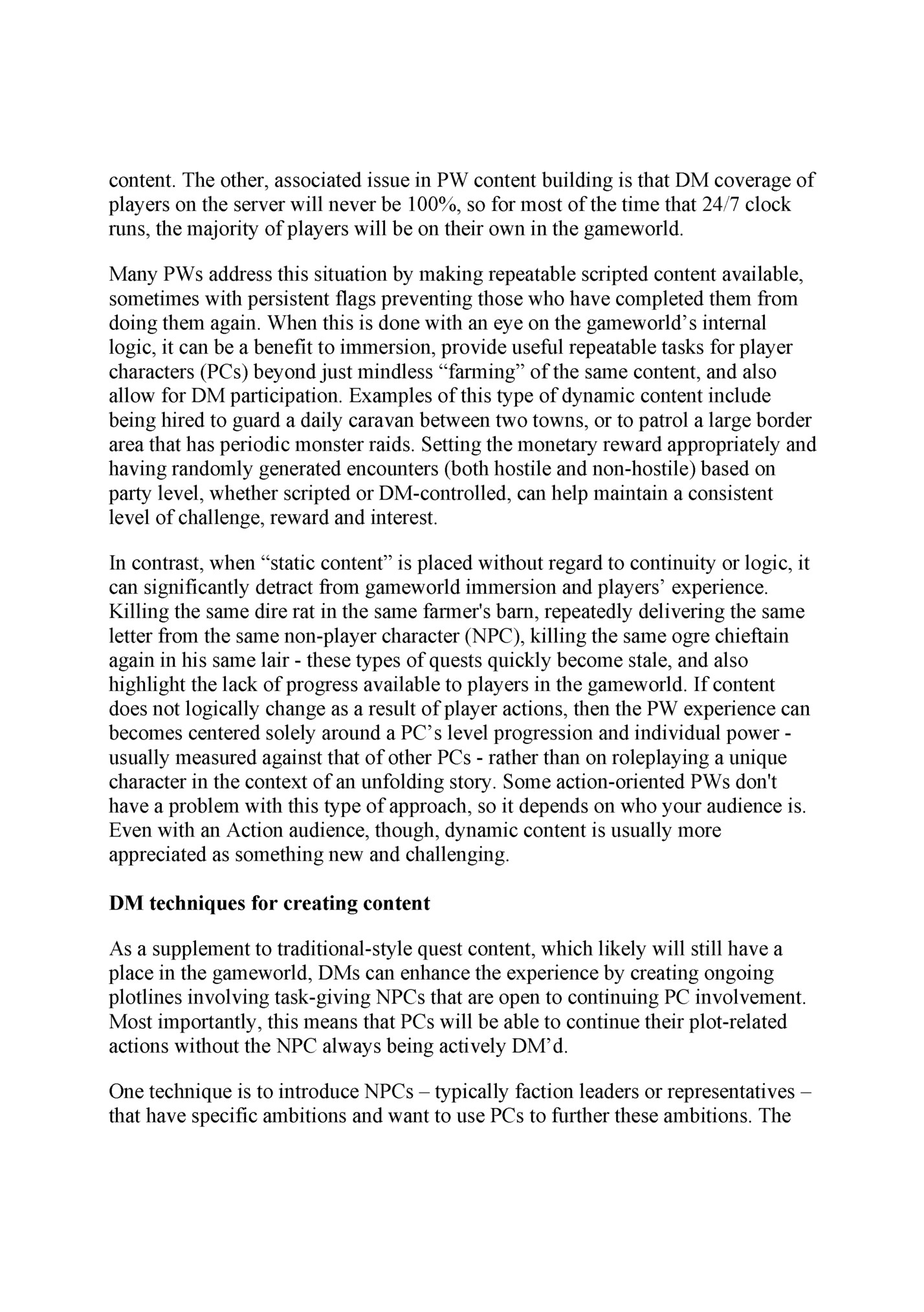
overall plot in motion, but the PCs are the ones who will drive events - even if they don't know exactly what is going on. One example of this from a Forgotten Realms PW setting was a newly-arrived NPC Zhentarim agent, who had the objective of setting himself up with a cover business in town. He had to find a business to purchase, convince the owner to sell it, and then move in. After this was done, he began to seek out information on the town's power structure, dig up possible dirt on important people, and start planning for possible thefts or assassinations to further his cause. The agent naturally needed PCs to help with all of these tasks. Some jobs seemed to be completely innocent, others drew PCs into what were clearly shady dealings. The point of this scenario is that there was always something - usually multiple somethings - that the NPC needed doing at any given point in time, which could involve multiple PCs. One example involved the Zhentarim agent directing one PC to spy on another PC who was engaged in some business dealings of interest to the agent. This produced an ongoing character vs. character situation, which livened up even things like mundane tavern talk, as the PC spy would carefully probe for information while attempting to hide his true agenda. Variations on this theme can easily be developed for PCs that are more combat or quest-oriented (and thus may avoid talking in taverns). For example, exploration or patrolling of risky, dangerous areas is a logically repeatable task that can generate a variety of different types of encounters (scripted or DM-created) and allow for PCs to progress both personally and in regards to the plot. Success or failure of PCs could subsequently be reflected in the areas becoming safer (or even more dangerous), promotions or demotions for those NPCs who gave the PCs the assignment, and so on. This brings up an important point: players love nothing more than seeing their actions affect the world around them. This is normally easier to implement in a DM'd campaign, as each new session can easily be updated and content adjusted based on the previous one’s results, but it can also be accomplished in a PW setting. Low-level PCs can have a measurable impact on the world, positive or negative, while mid-to-upper level PCs absolutely should be leaving their mark in tangible ways. NPCs and their associated factions who succeed or fail in their objectives because of the PCs are one aspect of this, while visible changes in the gameworld’s environment are another. While more complicated in-game systems for PCs like housing and ship travel are by now familiar, something as simple as a
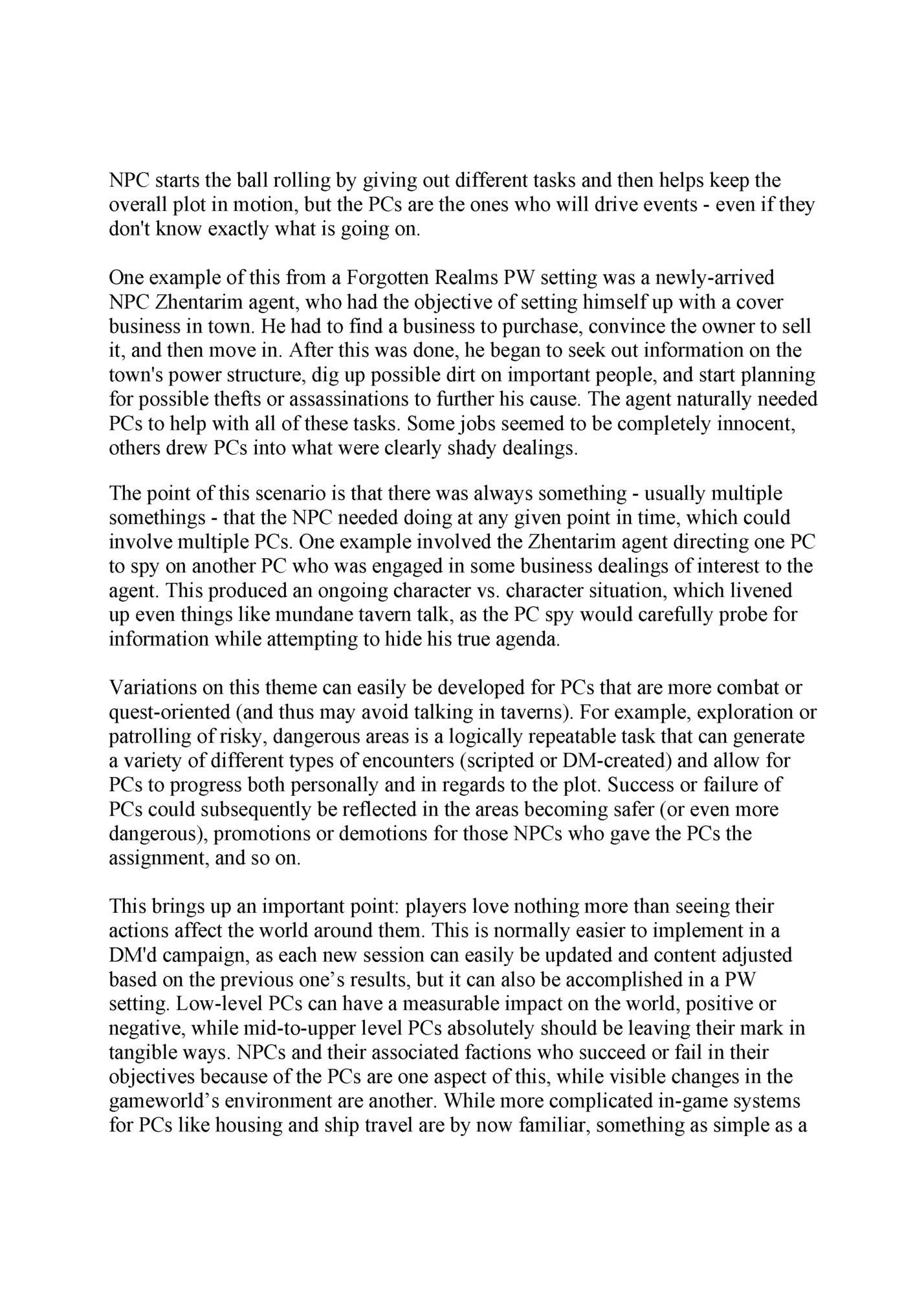
rewarding. To sum up, DMs should be able to show PCs that they are part of the world, while always have something going on in it that relates to PC activities. III. Consistency and Continuity In a traditional NWN campaign, it can occasionally be difficult for a single DM to keep track of everything going on with their players, although this is made much easier by taking notes and being able to refer to chat logs. PWs, however, often have multiple DMs who do not necessarily overlap on a regular basis while ingame, making gameworld continuity a significantly greater challenge. In a normal campaign, even if there are multiple DMs involved, there should be very little that comes as a surprise, since everyone is usually in-game at the same time and sharing the same overall experience. PWs, however, inherently have a problem of maintaining continuity – including with NPC interactions, storylines, and a consistent level of DM-granted rewards (XP, gold, items, etc.) An ideal situation for many players on PWs is when a DM can establish a regular schedule and be with more or less the same group on a consistent basis – a situation which resembles a traditional DM’d campaign. However, even when this is possible, there can still be balance and continuity issues with other DMs and player groups operating and overlapping in the gameworld space. One typical way for things to get out of whack is if one set of DMs give out relatively larger rewards than others – whether intentionally or not – thereby imbalancing the relationships between PCs, something which is often perceived as being unfair by other players. Establishing common guidelines and references Regardless of a PW’s size, core guidelines on items, treasure, and XP rewards should be created, updated when necessary, and understood by all DMs. There are a wide range of opinions on what the ideal balance of rewards is, so this will differ by project. The point is that for whatever PW you are on, the guidelines should be easily available to all DMs, consistent and clear. Having the same sheet of music for all concerned also helps keep DM-player interactions civil, both in and out of game (more on that below). All DMs should explicitly sign up to the guidelines and if there are any questions about them or the results of DM actions, the arbitration process should be clear, definitive, and quick.
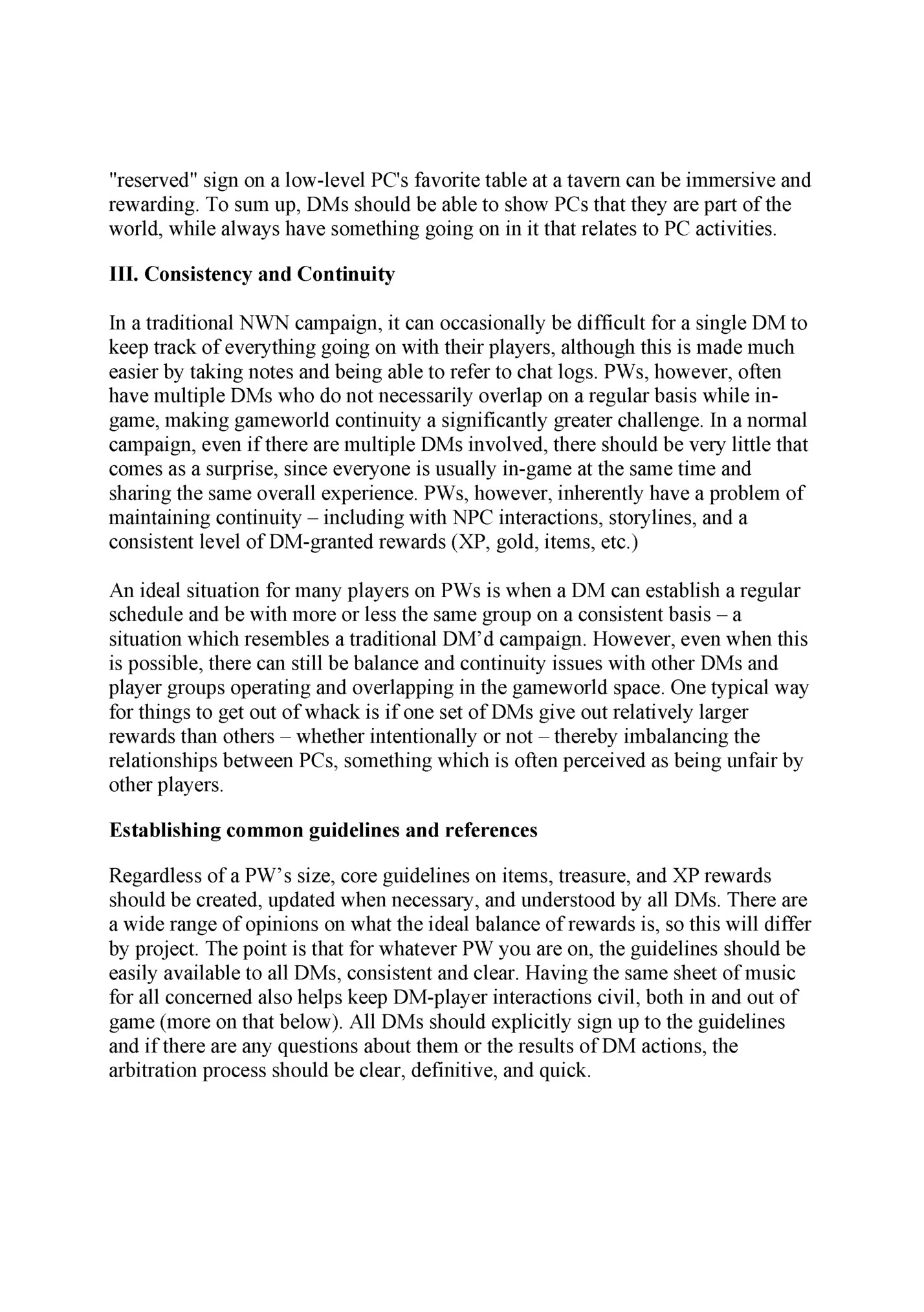
falls outside the guidelines, at the end of a particularly epic quest. This could be handled various ways: DMs might discuss on a private forum the item's potential future impact in the gameworld and come to a mutually-agreed conclusion; an individual might have been designated to review creation and distribution of magic items for the project; and so on. While it’s important not to stifle creativity and to allow for exceptional situations, compromises may have to be worked out to maintain gameworld balance. As long as DMs recognize that they have a responsibility both to individual players and to maintaining a fair system for all, these types of situations usually can be resolved to everyone’s satisfaction. A shared (private) DM reference for plotlines and NPCs is also fundamental. Summaries of important developments for plots and NPC interactions should be posted regularly. This admittedly can be a significant amount of work, if you are serious about running a roleplay-oriented world. If a DM doesn't know what's been going on, however, they can only fake it so long with players before screwing up something important in-game. From the DM’s point of view, it can also be a frustrating experience to have to "fly blind" with an NPC, if a PC starts referring to things that the NPC should know, but have not been documented anywhere. Almost nothing ruins a player's experience quicker than having a key NPC start acting differently with them for no apparent reason, for example not “remembering” significant interactions with the player. In addition to plotline references, it can be very helpful to keep a central NPC roster that has a summary of their personalities and backgrounds, along with a record of player interactions, so that DMs can prepare out-of-game as necessary. A variation of this idea ingame is to have a (no-drop) book object on an NPC, with the book description containing personality and background information. Few DMs have perfect memories and this can be a very helpful item if a DM is put on the spot in-game. IV. Community Relations In contrast with traditional campaigns or modules featuring only one DM and a small group of players, DMs on PWs normally have to collaborate either in-game or out-of-game with other DMs and make at least minor compromises on specific issues; as in any team environment, no one can get their way 100% of the time. Measures that help encourage cooperation among DMs and strengthen intracommunity relations can sometimes be neglected in favor of the fun (or oftentimes, unfortunately, “work”) of a PW - running DM’d sessions, constructing new content and plotlines, and other activities that keep the in-game world going. In a PW
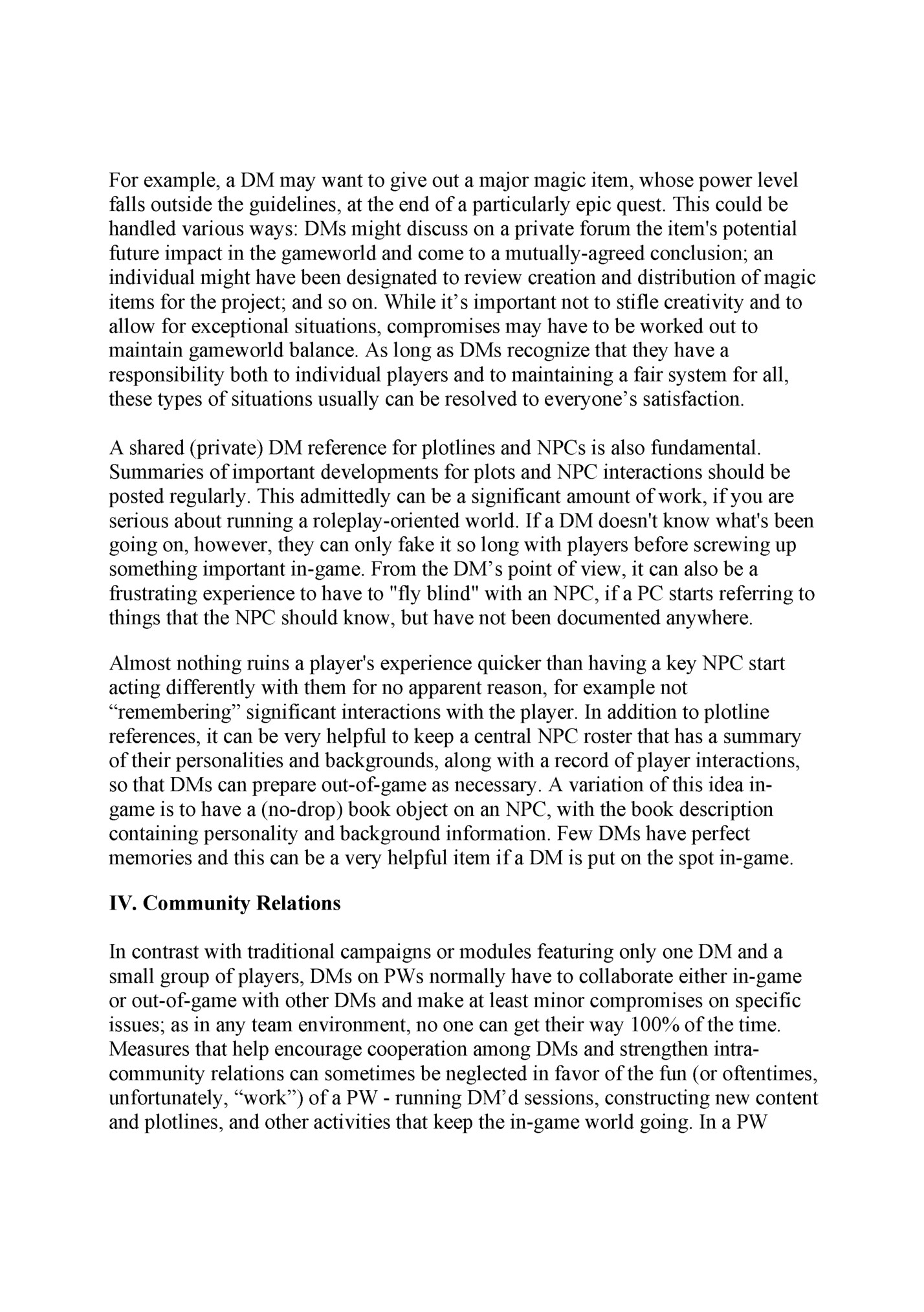
not least the sharing of plot and NPC developments, as mentioned above. It’s also important for DMs to be able to share their views and contribute ideas for the gameworld to their peers and to project managers. If this kind of DM community cooperation breaks down or is not encouraged in the first place, the gameworld will almost inevitably lose cohesion and DMs will become increasingly frustrated with each other, the players, and the project in general. Maintaining healthy forums for posting common references, along with keeping up with relevant Discord/chat topics, is fundamental. In addition, PWs hosting periodic DM meetings in real-time can go a long way to help foster and deepen a sense of community. Letting DMs bounce ideas off of each other and solve each other's problems as a group can be a powerful experience. Solutions can be found and ideas propagated much more rapidly while live, in comparison with forum posts or un-synced Discord chat contributions. Having a group session is also a way to ensure that everyone present has actually heard, understood, and had the opportunity to share their views on important proposals or changes. Internal procedures and resolving disputes Any project requires some sort of defined internal procedures for its members, especially regarding leadership roles and division of responsibilities. A small group of personal friends may not even need to have anything written down, which is fine. But for a project to grow in the longer term by attracting new people to its ranks, it eventually becomes a necessity to have some type of living document that describes, at minimum, what the project about and how responsibilities are shared within it. You don’t need to have a lawyer get involved, or make it terribly formal, but having a common template that everyone can understand and sign up to is helpful in organizing and running any project, especially when controversies arise (as they inevitably will). Some of the typical points of contention for DMs on PWs are: • Perceptions of favoritism. This occurs when some PCs are given in-game benefits - in whatever form, including more DM attention - beyond what other players receive. If a DM can show how their actions have been within the normal rules and expectations for the project, then this can defuse accusations of personally biased treatment. It also helps to avoid inadvertently creating these situations. For example, if DMs aren’t fully aware of established treasure guidelines, they may well violate them
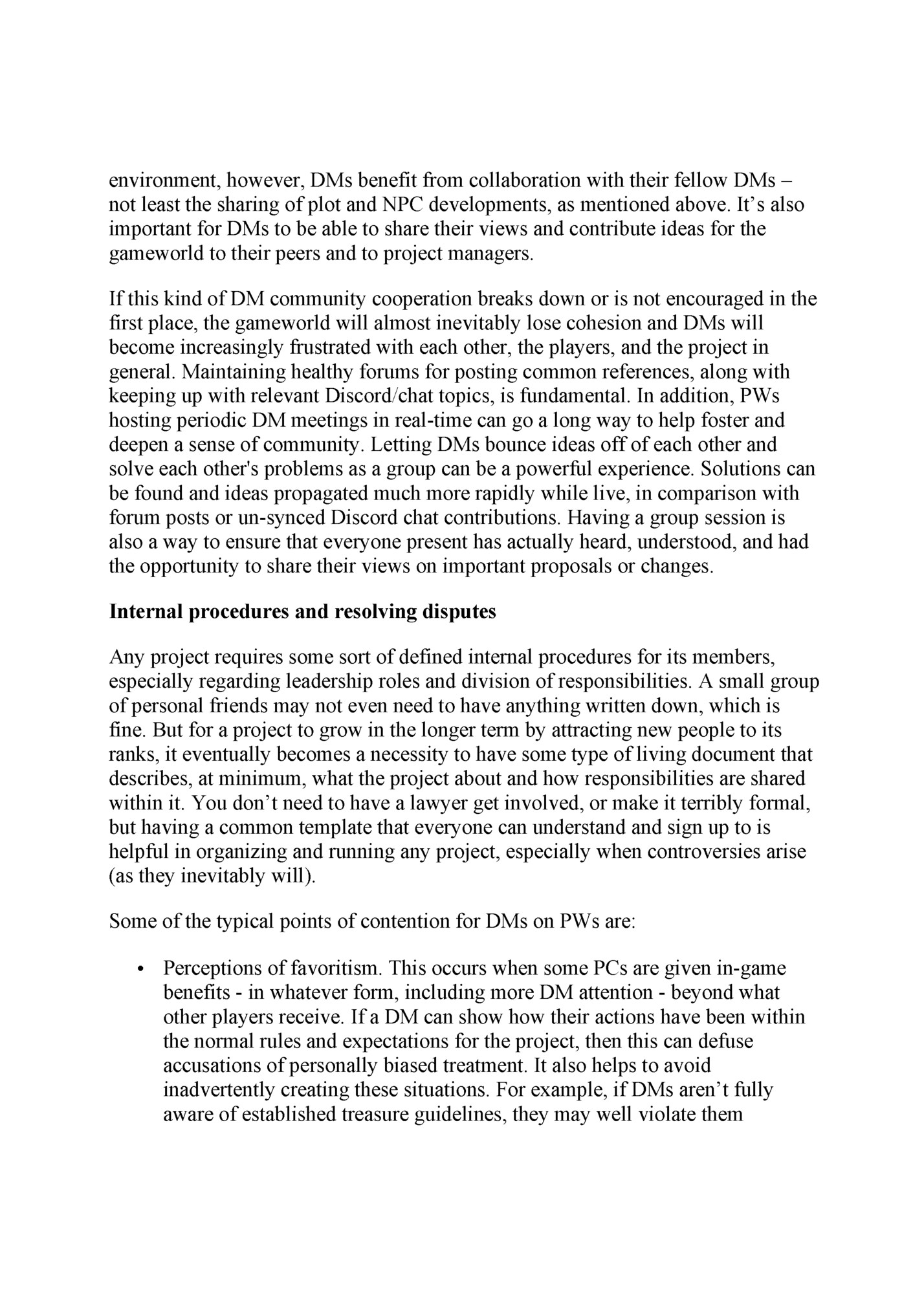
Fleepit Digital © 2021